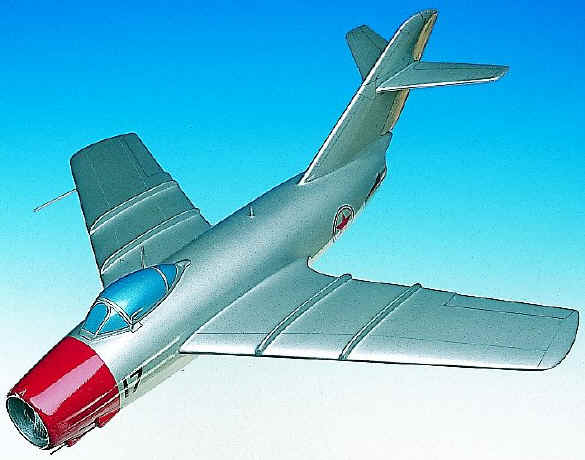|
|
|
 |
Mig-15
Fagot,
Soviet Union - 1950 |
The MiG-15
began life just after WWII when the Soviet Air Force charged the
major Soviet aircraft design bureaus with developing a
high-altitude day interceptor able to operate from rough strips,
reach Mach 0.9, have good maneuverability at high altitude,
carry heavy armaments and have a flight endurance of over one
hour. This was quite the demand considering that they didn't
have a decent jet engine. They purchased an excellent power
plant, the Rolls-Royce Nene jet engine, from the British who
were desperate for hard cash. The configuration, with the
high-set swept wing, high tailplane and nose intake was inspired
by the German Focke Wulf Ta-183 design. The Americans code-named
it "Fagot."
The aircraft caught the Americans by
surprise when it appeared in combat in Korea on November 1,
1950. The Americans were flying their first jet fighter, the
F-80 Shooting Star, and P-51 Mustangs. The MiG-15 totally
outclassed them and the new Thunderjet with superior speed, rate
of climb, fire power, range and ceiling. However, American
combat pilots shot down several MiG-15s. In December 1950,
the new F-86 was delivered. Even then the MiG-15 had a
higher rate of climb, equal maneuverability and could dive
faster. The West was shaken out of its complacent attitude
toward Soviet fighter capabilities in the Korean skies.
Fortunately Korean and Chinese pilots were timid and the Russian
pilots reputed to be flying with them were not numerous enough
to make a big difference in Korea.
Most Warsaw Pact nations
bought and flew the MiG-15, and its variants remained in service
in the air forces of China, Egypt, North Korea and Syria until,
in some cases, the 1980s. |
|

|
Mig-15 Faggot
Deluxe Series. 1/32nd scale. 12.35" wingspan x
12.5" long.
No. AFW3D-DX. Only $129.95 |
|
